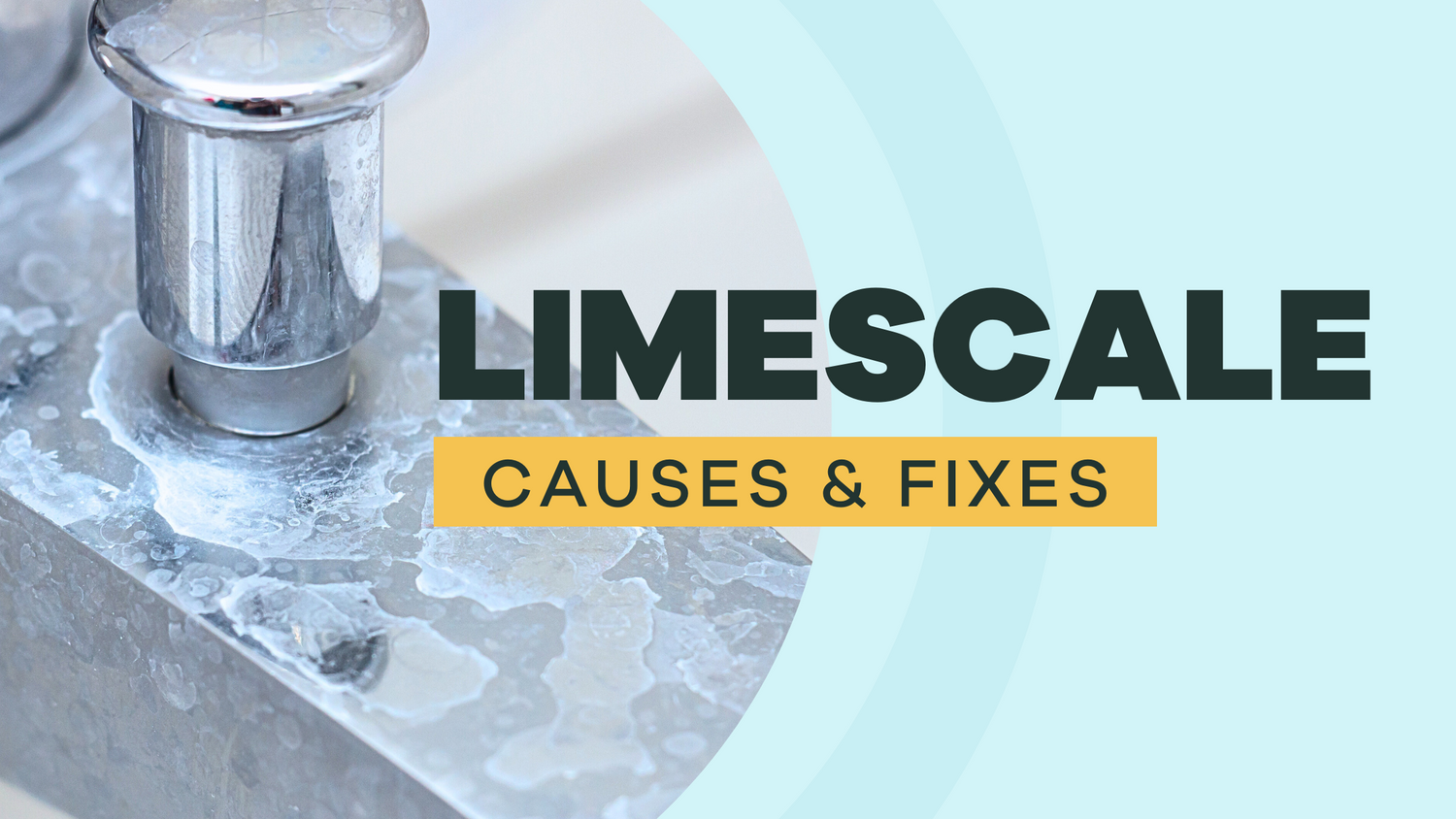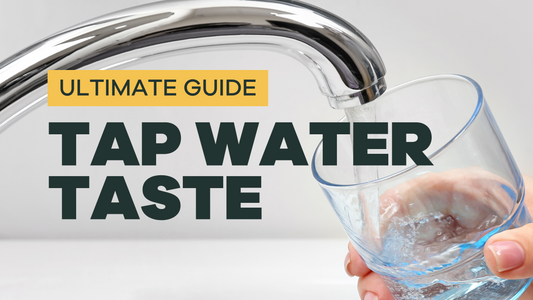
What’s the White Residue on My Fixtures?
Our blog is written by real experts— not AI. Each guide is carefully reviewed and updated based on the latest research. Plus, with no affiliate links, you can count on unbiased insights you can trust.
Do you see white residue on your faucets, shower heads, and just about any surface your water touches? You’re not alone if you sat down to search for an explanation to the white spots, film, and build-up which seems to be plaguing your glassware, faucets, shower heads, shower glass, and beyond.
Good news: It’s not harmful to your health, but while it may be bad news for your appliances, there are easy fixes.
Table of Contents:
- What Is that White, Chalky Buildup?
- Is Limescale Bad for My Health?
- Is Limescale Bad for My Home?
- How Do I Get Rid of Limescale?
- How Do I Get Rid of Hard Water?
Key Takeaways
- The white residue you see on fixtures and glassware is the result of minerals carried through your tap water and typically called "limescale." Higher amounts of mineral deposits usually signify higher levels of water hardness.
- Limescale is harmless to human health. But it can build up in your pipes, which can cause pressure and pipe integrity problems over time. This extends to the smaller pipes attached to appliances like washing machines, dishwashers, water heaters, and even your freezer’s ice maker.
- Vinegar and baking soda are great tactics for removing limescale residue from your fixtures, cookware and glassware, and even laundry machine. But reducing water hardness levels will require investing in a water softener or reverse osmosis treatment system. Test your water to find out how hard your water is.
What Is this White, Chalky, Spotty Buildup?
The white residue you see on fixtures and glassware is the result of minerals carried through your tap water. Higher amounts of mineral deposits usually signify higher levels of water hardness. This nuisance deposit from drinking water is pervasive across the US (see the map below).

USGS Map showing water hardness results from well testing across the US by National Water Quality Association Program in 2014.
Hardness refers to the total amount of calcium, magnesium, and occasionally other minerals (e.g. silicate) in your drinking water. As water flows through limestone and chalk in the environment, it dissolves the calcium, carbonates, and magnesium that comprise the bulk of water hardness.
In areas with hard water, these minerals precipitate out of your tap water onto surfaces. This is why you find residue most commonly on your faucets, shower heads, pots and pans, and anything that comes out of the dishwasher. You might hear this chalky white substance called “limescale,” or “calcium buildup.”

via Shutterstock
What If I Have White Residue But Soft Water?
If you see white spots on your fixtures, even though your water tests as soft, the culprit could could be silica. There's no exact threshold for when silica becomes an issue, but many sources suggest that aesthetic problems—like etching on glass or buildup of deposits—tend to appear around 20 parts per million (PPM) of silica. However, this isn't a strict limit. Some people might notice these issues at lower or higher levels.
Is Limescale Bad for My Health?
Water hardness is largely believed to be harmless to human health. In fact, some research suggests that exposure to calcium and magnesium may have protective effects against cardiovascular disease, though evidence is still not definitive.
If water hardness causes any issues, it is usually aesthetic—e.g. taste or staining on clothing—or plumbing and appliance-related.
Is Limescale Bad for My Home?

If your water has high water hardness, scale can build up in your pipes, which can cause pressure and pipe integrity problems over time. Not only can this negatively influence the pipes that bring water to your home, but also the smaller pipes attached to appliances like washing machines, dishwashers, water heaters, and even your freezer’s ice maker.
If this is the case, you’ve likely noticed a lot of limescale around your home. Testing your water for hardness can give you a clear indication of whether you need to invest in a treatment solution.
The Best Water Testing Kits of 2025
How Do I Get Rid of Limescale?
Fortunately, there are some great natural remedies to rid your sinks, showers, and cookware of limescale.
Note: When limescale reacts with soap (think shower and tub), it can form mineral deposits known as "soap scum"—this is white to off-white in color, and you should be able to remove it the way you remove limescale.
Removing Limescale on Sinks and Faucet Heads:
Soak a cloth or towel in vinegar. Wrap it around your tap and let soak for 30-60 minutes depending on how much build up you have. Remove, scrub, and wash with soap and water.
Removing Limescale in Toilet Bowl:
If you have build up in the toilet, a little vinegar and baking soda will go a long way:
- Turn off water to toilet and then flush so the water level is low and you can see deposits.
- Spray or rub vinegar on deposits and let sit for 30-45 minutes.
- Then, scrub deposits with a toilet brush. If this works, turn the water on and end here.
- If you still see deposits, add baking soda and scrub.
- This should do the trick, but a pumice stone scrub will take off any recalcitrant deposits.
Removing Limescale on Washing Machine:
This method wastes a bit of water, but if your washer is filled with deposits, you may need to run through this routine:
- Run a hot cycle (empty) with 1 cup of baking soda.
- Clean the inside of the washer with a cloth.
- Run a second hot cycle (empty) with 1 cup vinegar.
Removing Limescale from Pots and Pans:
For heavily scaled pots and pans:
- Fill pot with a 3:1 ratio of water to vinegar.
- Bring to boil, then turn off and let sit until water is warm.
- Use warm water with a sponge to scrub off the mineral deposits.
- Wash regularly.
How Do I Get Rid of Hard Water?
If you need to reduce water hardness, your options include:
- Investing in a water softener that uses salt-based ion exchange technology.
- Investing in a water softener that uses non-salt-based technology
- Investing in a reverse osmosis treatment system (RO), but you’ll need to maintain your RO system often if your water hardness is high; this can be expensive.
The following infographic can help your decision-making once you've tested your water:

While all of the above options are helpful to remediate what’s already been done, they do not eliminate water hardness from your water. Sometimes tap water is too hard and will not taste good (usually over 180 PPM or mg/L, measured by calcium carbonate).
Read More
▾General Chemistry of Water | SimpleLab Tap Score
The Drinking Water Taste Guide | SimpleLab Tap Score
The Stain Guide: What You Can Do About Stained Clothes
Tap Score Water Testing Packages
Do I Need a Water Softener? | SimpleLab Tap Score
How Does Ion Exchange Work? | SimpleLab Tap Score
What is Reverse Osmosis (RO)? | SimpleLab Tap Score
Why Is My RO Water Filter Leaking? | SimpleLab Tap Score
Sources and References
▾- USGS Circular 1332 Quality of Water from Domestic Wells in Principal Aquifers of the United States, 1991–2004; Overview of Major Findings
- Spatial analysis of the relationship between mortality from cardiovascular and cerebrovascular disease and drinking water hardness
- Addressing hard water and scale with sustainable solutions
- Toilets | How to Remove Calcification From Toilets
- How To Descale Your Washing Machine-House Cleaning and Stain Removal Tips










